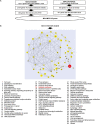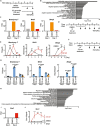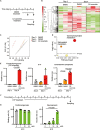Lethal Phenotype-Based Database Screening Identifies Ceramide as a Negative Regulator of Primitive Streak Formation
- PMID: 37819786
- PMCID: PMC10722545
- DOI: 10.1093/stmcls/sxad071
Lethal Phenotype-Based Database Screening Identifies Ceramide as a Negative Regulator of Primitive Streak Formation
Abstract
In early embryogenesis, the primitive streak (PrS) generates the mesendoderm and is essential for organogenesis. However, because the PrS is a minute and transient tissue, elucidating the mechanism of its formation has been challenging. We performed comprehensive screening of 2 knockout mouse databases based on the fact that failure of PrS formation is lethal. We identified 812 genes involved in various cellular functions and responses that might be linked to PrS formation, with the category of greatest abundance being "Metabolism." In this study, we focused on genes of sphingolipid metabolism and investigated their roles in PrS formation using an in vitro mouse ES cell differentiation system. We show here that elevated intracellular ceramide negatively regulates gene expression essential for PrS formation and instead induces neurogenesis. In addition, sphingosine-1-phosphate (a ceramide derivative) positively regulates neural maturation. Our results indicate that ceramide regulates both PrS formation and the induction of neural differentiation.
Keywords: cardiac differentiation; ceramide; neural differentiation; primitive streak; sphingosine-1-phosphate.
© The Author(s) 2023. Published by Oxford University Press.
Conflict of interest statement
The authors declared no potential conflicts of interest.
Figures








Similar articles
-
Short-Term Memory Impairment.2024 Jun 8. In: StatPearls [Internet]. Treasure Island (FL): StatPearls Publishing; 2025 Jan–. 2024 Jun 8. In: StatPearls [Internet]. Treasure Island (FL): StatPearls Publishing; 2025 Jan–. PMID: 31424720 Free Books & Documents.
-
Prolyl-tRNA synthetase inhibitor as a novel first-in-class keloid treatment: downregulation of de novo collagen synthesis and inflammatory cascade.Br J Dermatol. 2025 Jul 17;193(2):298-309. doi: 10.1093/bjd/ljaf140. Br J Dermatol. 2025. PMID: 40233147
-
Signs and symptoms to determine if a patient presenting in primary care or hospital outpatient settings has COVID-19.Cochrane Database Syst Rev. 2022 May 20;5(5):CD013665. doi: 10.1002/14651858.CD013665.pub3. Cochrane Database Syst Rev. 2022. PMID: 35593186 Free PMC article.
-
Home treatment for mental health problems: a systematic review.Health Technol Assess. 2001;5(15):1-139. doi: 10.3310/hta5150. Health Technol Assess. 2001. PMID: 11532236
-
The Black Book of Psychotropic Dosing and Monitoring.Psychopharmacol Bull. 2024 Jul 8;54(3):8-59. Psychopharmacol Bull. 2024. PMID: 38993656 Free PMC article. Review.
Cited by
-
Transcriptomics analysis reveals potential regulatory role of nSMase2 (Smpd3) in nervous system development and function of middle-aged mouse brains.Genes Brain Behav. 2024 Aug;23(4):e12911. doi: 10.1111/gbb.12911. Genes Brain Behav. 2024. PMID: 39171374 Free PMC article.
References
-
- Desbaillets I, Ziegler U, Groscurth P, Gassmann M.. Embryoid bodies: an in vitro model of mouse embryogenesis. Exp Physiol. 2000;85(6):645-651. - PubMed
Publication types
MeSH terms
Substances
Grants and funding
LinkOut - more resources
Full Text Sources
Molecular Biology Databases

